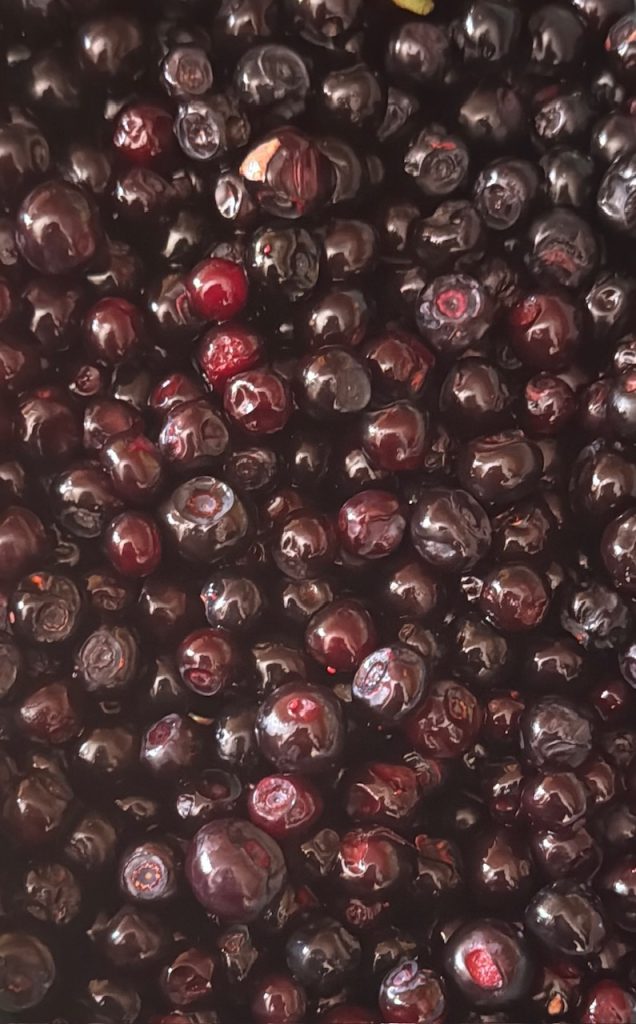Last weekend we went to the mountains to hand pick Huckleberries. When people think of superfruits, blueberries, acai, or pomegranates often come to mind. But tucked away in the forests of North America lies another berry that has been cherished for centuries: the huckleberry.
Small, tart, and deeply flavorful, huckleberries grow wild in the mountains and woodlands of the Pacific Northwest, the Rocky Mountains, and parts of Canada. They’ve long been a favorite among foragers, chefs, and health-conscious foodies. In this article, we’ll dive into the history, nutrition, and many uses of huckleberries, and explore why this wild fruit deserves a bigger spotlight.
What Are Huckleberries?
Huckleberries are small, round berries that resemble blueberries, though they are darker in color and usually have a bolder, more tart flavor. Unlike blueberries, which are widely cultivated, huckleberries are mostly wild-harvested because they don’t grow well in commercial farming environments.
They belong to the genus Vaccinium and come in several varieties—red, blue, and black huckleberries being the most common. The flavor ranges from sweet to tangy, depending on the type and ripeness.
A Forager’s Delight
One of the unique things about huckleberries is that they’re not widely available in supermarkets. Instead, they are typically picked fresh by hand in the wild. Many people in Montana, Idaho, Oregon, and Washington spend summer days hiking mountain trails with buckets in hand, searching for patches of ripe berries.
Because they are wild and seasonal, huckleberries are often considered a rare and special treat. Local festivals, like the annual Huckleberry Festival in Montana, celebrate the fruit with pies, jams, pancakes, and even huckleberry ice cream.
Nutritional Value and Health Benefits
Huckleberries aren’t just delicious—they’re also packed with nutrients.
- Rich in antioxidants: Like blueberries, huckleberries contain anthocyanins, compounds that give them their dark color and help protect against cell damage.
- Vitamin C: Supports the immune system and skin health.
- Iron and potassium: Important minerals for energy and muscle function.
- Fiber: Aids in digestion and helps maintain satiety.
Health Benefits of Huckleberries
- Supports heart health – Antioxidants and fiber work together to lower cholesterol and reduce inflammation.
- Improves vision – Some research suggests berries rich in anthocyanins may support eye health.
- Boosts immunity – High vitamin C content makes huckleberries a natural immune supporter.
- Balances blood sugar – Their fiber content helps regulate blood sugar levels, making them a smart snack for energy.
Cooking with Huckleberries
Because of their tart-sweet flavor, huckleberries are extremely versatile in the kitchen. They can be used much like blueberries but often add a more intense taste.
Sweet Uses
- Huckleberry Pie: A classic dessert in the Pacific Northwest.
- Pancakes & Muffins: Fold huckleberries into batter for a burst of flavor.
- Jams & Syrups: Popular as gifts and perfect for drizzling over ice cream.
- Cheesecake Topping: Their tang pairs beautifully with creamy desserts.
Savory Uses
- Huckleberry Glaze: Works wonderfully on pork or duck.
- Salad Garnish: Toss a handful onto greens with goat cheese and walnuts.
- Sauces for Cheese Boards: Tart huckleberry chutneys complement sharp cheeses.
Huckleberries vs. Blueberries
While huckleberries and blueberries look similar, there are key differences:
| Feature | Huckleberries | Blueberries |
|---|---|---|
| Growth | Wild, rarely cultivated | Widely farmed |
| Flavor | Tart, bold, intense | Mild, sweet |
| Availability | Seasonal, local farmers/markets | Year-round, supermarkets |
| Color | Darker, almost black-purple | Blue to light purpl |
Cultural and Historical Significance
For centuries, Native American tribes used huckleberries as food, medicine, and even trade goods. They were eaten fresh, dried for winter storage, or mixed into pemmican (a high-energy food made with meat and fat). The berries were also used in teas and remedies for ailments such as colds and digestive issues.
Today, they remain an important part of regional identity in the Pacific Northwest. Restaurants and bakeries in Montana, Idaho, and Washington often highlight “huckleberry specials” on their menus during harvest season.
Challenges of Cultivation
Unlike blueberries, huckleberries resist domestication. Attempts to farm them on a large scale have mostly failed because they rely on very specific soil and environmental conditions found in the wild. This makes them more expensive and harder to find outside their growing regions.
For this reason, huckleberry products—like jams, syrups, and candies—are often prized as specialty items and sold in tourist shops throughout huckleberry country.
Where to Find Huckleberries
- Farmers’ markets in the Pacific Northwest during summer months.
- Specialty stores carrying jams, syrups, or dried huckleberries.
- Foraging trips—if you’re in the right region, you can pick them yourself (just be sure to follow local rules and be bear-aware!).
- Online shops—many companies now ship huckleberry preserves and products nationwide.
Why You Should Try Huckleberries
If you’ve never tasted a huckleberry, you’re missing out on one of North America’s most unique wild foods. Their intense flavor, cultural history, and health benefits make them more than just another fruit—they’re an experience.
Whether you try them fresh in a pie, drizzled as syrup over pancakes, or in a savory sauce, huckleberries bring a touch of the wild to your plate. And because they can’t easily be mass-produced, every bite feels like a seasonal, special treat.
Final Thoughts
Huckleberries are more than a blueberry cousin—they are a distinct, flavorful, and nutritionally powerful berry with deep roots in North American history. Their rarity adds to their appeal, making them a beloved symbol of the Pacific Northwest and beyond.
From pies to sauces, jams to smoothies, there’s no shortage of ways to enjoy them. If you’re ever traveling through huckleberry country, make it a point to try them fresh—you’ll quickly understand why locals celebrate this wild berry every summer.
Until then, huckleberry jams, syrups, and treats offer the next best way to taste this wild superfruit.
Huckleberry Harvest Breakfast Bowl with Banana Bread “Croutons”:
Ingredients (should be for 2 servings, I eat it just by myself…):
- 1 ripe banana
- 1 cup plain greek yogurt (or coconut yogurt for the vegan variant)
- ½ cup fresh huckleberries (or blueberries)
- 1 tbsp honey or maple syrup
- ¼ tsp cinnamon
- 1 slice homemade banana bread (day-old works best)
- roasted walnuts
- 1 tsp chia seeds
Steps:
- Cube the slice of banana bread into small “croutons,” toast lightly in a skillet or oven until crisp edges form
- Blend the banana with yogurt, honey, and cinnamon until smooth
- Pour into bowl(s), swirl in the huckleberries (save a few for topping)
- Sprinkle toasted banana bread croutons, pumpkin seeds, chia seeds, and reserved berries on top

